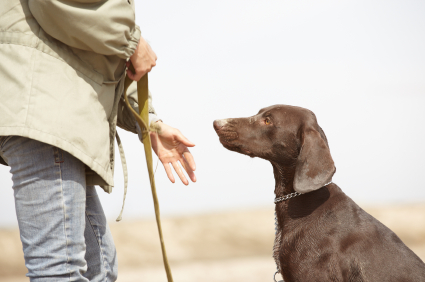I am often asked if I ever use corrections during training exercises with my animals. And in short, the answer is “no”; however, there are times when it would be appropriate to interrupt a particular undesirable behaviour, and by definition, this would be punishment.
But my goal with an interruption is to create a pause in behaviour to quickly redirect the animal to a new and more appropriate behaviour choice and an opportunity to earn reinforcement. I do not expect my interruptions to influence future occurrences of that particular behaviour.
There are many reasons why I, and most animal trainers and behaviour consultants who employ science-based training exercises in their animal education courses, choose not to use punishment. This article will address ten reasons that punishment will not help you train your dog. In this article, the terms “punishment” and “aversive training” refer to any harsh physical correction used in an attempt to influence behaviour choices by an animal.
10 reasons why Punishing a dog is wrong
The information presented below is based on the experience of Niki Perry, CPDT-KA, KPACTP and the facts and research taken from the works of B.F. Skinner, K. Pryor, M. Breland-Bailey.
- Teaches them what NOT to do
The use of punishment only as a means to teach an animal is an incomplete training program because it only teaches the animal what NOT to do. Whereas reinforcement gives precise information to the animal as to what is expected of them, it influences appropriate behaviour choices with very few steps involved in the training process.
- Suppresses behaviour
Aversive training may suppress action but not get to the root of the function of that particular behaviour. This can be particularly dangerous when warning signals such as growling or baring teeth are punished in dog training. The result may be that the dog resorts right to the biting action without warning.
When proper applied behaviour analysis is employed in a behaviour change program by an experienced behaviour consultant, the root motivation of the problematic behaviour can be identified and carefully counter-conditioned. A new association is created through these techniques, and new, more appropriate alternative behaviours are taught through positive reinforcement training systems.
- Confusion and mistrust
Punishment can cause great confusion and mistrust, and this is especially true if emotion such as a human’s frustration plays a part in the punishment.
Not too many people can say they’ve punished their dog without emotion playing a part. In most instances, the human is very upset, angry or frustrated when they punish their dog. It’s best not to use intimidation, force or physical manipulation and instead use kind, consistent teaching systems to avoid creating aversive contingencies within your relationship with your animal.
- Wrong conclusions
Punishment might lead to the wrong conclusion due to delivery timing and could cause the dog to substitute with another problematic behaviour. Very few people can time punishment to influence future occurrences of a particular behaviour effectively. Therefore, in many cases, punishment just ends up being an outlet for frustration, as discussed above.
- Induce fear
The use of non-contingent punishment can add another dimension of fear or arousal to fear-based aggression, which will only compound the problem.
When the timing of the delivery of the punishment is off, even by a couple of seconds, the dog will not understand why they were punished. As discussed above, when the timing is off, it may lead to the wrong conclusion, and in many cases, it may cause your dog to mistrust you – the one they should be able to look to for guidance, love and support.
- Learned helplessness
Aversive training, particularly repetitive use of aversive stimuli during exercise, can cause learned helplessness. In other words, the dog decides that everything they do causes a punishing consequence, so they stop trying.
This is the case of the “calm submissive” dog that you see on T.V., the dog is not in a “calm submissive” state, but actually, the dog has been punished so many times without knowing why that they have given up trying to earn reinforcement. It’s pretty sad, and many dogs require rehabilitation after experiencing training that resulted in learned helplessness.
- Reinforcing bad behaviour
Sometimes what seems like punishment to the human is actually reinforcement for the dog’s behaviour. For example, if a particular behaviour’s function is to gain attention and the dog receives a verbal reprimand, it worked in the dog’s mind!
- Likely to happen again
For the punishing consequence to be effective in influencing future behaviour, it must be delivered consistently every time it occurs. Let’s be honest; this is impossible. You can’t possibly be everywhere all the time to punish behaviours, and since all it takes is one chance at “self-reinforcement” for a behaviour to be likely to occur again, it is pointless to use punishment.
Instead, it would be more effective to use empowerment-training techniques that focus on teaching your dog how to make their own appropriate behaviour choices. Only through the reinforcement of desired behaviours will the dog start to choose those options over the undesirable behaviours they are currently performing.
- Bad experience
Punishment does not carry over well from experience to experience. Just because the animal was punished for one thing doesn’t mean they will understand that discipline will occur for each instance similar to the original behaviour. For example, just because a dog was punished for chewing a shoe, it doesn’t mean they understand not to chew at all.
A more effective approach to this would be to understand that chewing is a very natural behaviour in dogs and can be very healthy for them, so teach your dog what they can chew on. If you find your dog chewing on a chair, you can gently interrupt him and guide him to chew on an appropriate object like a yummy, stuffed Kong. This would be a great time to practice confinement training in a crate or quiet room if you need to.
- Repeated abuse
To be effective, punishment needs to be delivered with intensity and perfect timing once. If you have to continue to punish an animal for the same behaviour, the consequence is not influencing future behaviour. Repeated physical punishment in the name of training without proper effect constitutes abuse. Also, it may cause a “punishment callus,” and eventually, the level of intensity required would have to be stronger than what you started with.
How can I punish my dog?
No doubt reading that top 10 list of why punishment fails, you might be scared to ask the question should I punish my dog? Well, to know the answer to that question, let’s focus on the word ‘punish.’ The word punish has such a negative connotation to it that it can trigger back memories to days we were younger being scolded by relatives or school teachers, that it’s not always wise to use. Punishment can be associated with fear or aggression and not be used positively.
Instead, let’s ditch the word punishment and focus on discipline. The word discipline alone helps you think of more productive and practical ways to correct your dog’s bad behaviour instead of scolding them for it. To help you discipline your dog, here are some top tips to follow:
Amend your dogs behaviour
If your dog has made a mistake, provide them with a non-aggressive cue to show them they’ve misbehaved. Typical things you could do are saying phrases like “be careful,” “think again,” “watch what you’re doing” in a positive yet corrective tone. The tone must suggest that they need to improve your behaviour; otherwise, your dog could mistake it for praise.
Withdraw your attention
Another way to show your dog they’re in the wrong is that you can turn your back to them. If you remove your attention, this might get their brains thinking about what they’ve done wrong and reconsider their behaviour. After all, dogs are friendly and love to remain in the center of attention.
Don’t provide attention
Sometimes dogs are naughty because they are secretly demanding extra attention. If you shout at your dog during these periods, it might be reinforcing their bad behaviour. They could see shouting as a sign of being praised. Therefore they could repeat this behaviour to get more attention from you.
Stop bite inhibition
Some dogs, when growing up, might be prone to bite, and others could bite to get attention. When your dog nips at you, you should provide high-pitched yelp, remove your hand away immediately and stop playing with them. Over time doing this, your dog will learn to understand that rough behaviour like biting is wrong.
Conclusion
Punishment often fails when training your dog as it can induce fear, encourage them to repeat the behaviour, increase confusion and mistrust and encourage learned helplessness.
It’s essential to reconsider the word punishment and class it more as a discipline. If you want to discipline your dog, you should consider amending their behaviour, withdrawing your attention, not providing the attention, and reducing bite inhibition.
If your dog has extreme behaviours such as aggression, extreme fear and phobias, please do not attempt behaviour change protocols without a highly training and credentialed behaviour consultant. Certified Canine Behavior Consultants are knowledgeable and experienced professionals who can safely guide you through a systematic behaviour change program.
To find a behaviour consultant or dog trainer in your area, visit www.ccpdt.org or www.karenpryoracademy.com.
FAQS
How long do you punish your dog?
When punishing your dog, you should not do it for longer than 5 seconds. If you do it any longer, you could create confusion as to why they’re being punished. This amount of time will prove beneficial over 2-3 attempts.
Do dogs understand why they are being punished?
Unlike humans, dogs do not always understand why they’re being punished or the consequence of their actions. So depending on how you punish, it could cause a lot of problems such as fear, aggression and sadness in your dog.
How do dogs apologize?
Dogs tend to droop their ears when they’re apologetic and have wide eyes. Alongside this, they stop wagging their tails and panting. If you do not forgive their behaviour, they may paw their face or rub their face against your leg.
Do dogs stay mad at you?
While your dog can definitely show emotions like being upset, they can’t be mad at you. If they look angry, it’s most likely your dog is acting out, and the reason they’re doing so is boredom. Dogs tend to live in the moment, so any bad or negative emotion you see will go away once they become happy again.





